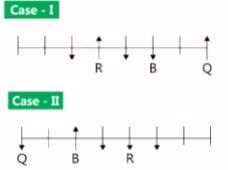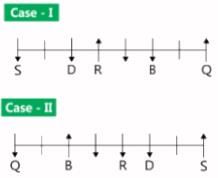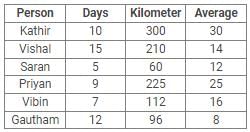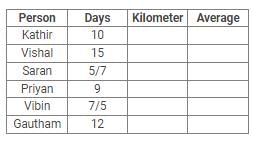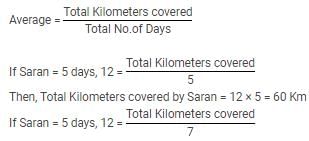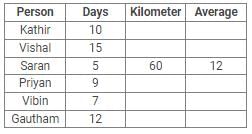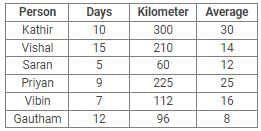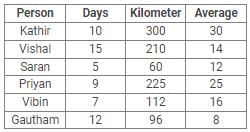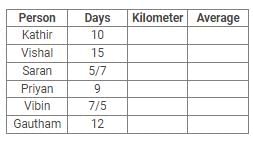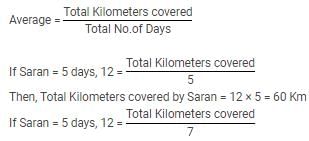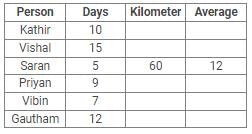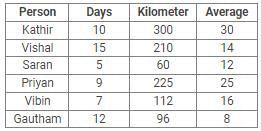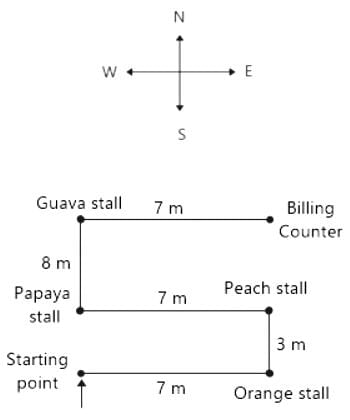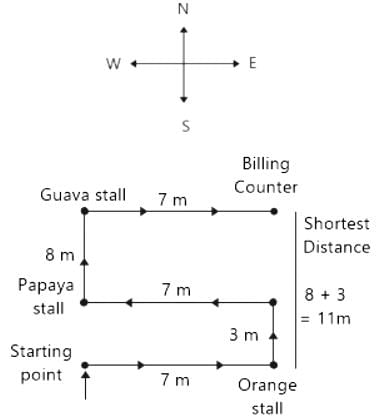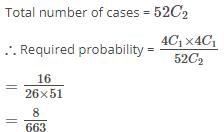EPFO Assistant Prelims Mock Test - 5 - Bank Exams MCQ
30 Questions MCQ Test Mock Test Series for EPFO Assistant 2026 - EPFO Assistant Prelims Mock Test - 5
Directions: A word and number arrangement machine, when given an input line of words and numbers, rearranges them following a particular rule in each step. The following is an example of input and rearrangement.
Input: jack 35 and 80 riya 45 play 70
Step 1: 35 jack and 80 riya 45 play 70
Step 2: 35 45 jack and 80 riya play 70
Step 3: 35 45 70 jack and 80 riya play
Step 4: 35 45 70 80 jack and riya play
Step 5: 35 45 70 80 riya jack and play
Step 6: 35 45 70 80 riya play jack and
Now, following the same rules, rearrange the given input of words and numbers, and answer the question given below.
Input: jack 88 sell 70 his 87 apple 90 tree
Q. Which of the following is Step 4?
Step 1: 35 jack and 80 riya 45 play 70
Step 2: 35 45 jack and 80 riya play 70
Step 3: 35 45 70 jack and 80 riya play
Step 4: 35 45 70 80 jack and riya play
Step 5: 35 45 70 80 riya jack and play
Step 6: 35 45 70 80 riya play jack and
Input: jack 88 sell 70 his 87 apple 90 tree
Directions: A word and number arrangement machine, when given an input line of words and numbers, rearranges them following a particular rule in each step. The following is an example of input and rearrangement.
Input: jack 35 and 80 riya 45 play 70
Step 1: 35 jack and 80 riya 45 play 70
Step 2: 35 45 jack and 80 riya play 70
Step 3: 35 45 70 jack and 80 riya play
Step 4: 35 45 70 80 jack and riya play
Step 5: 35 45 70 80 riya jack and play
Step 6: 35 45 70 80 riya play jack and
Now, following the same rules, rearrange the given input of words and numbers, and answer the question given below.
Input: jack 88 sell 70 his 87 apple 90 tree
Q. Which step would give the following output?
70 87 88 90 jack sell his apple tree
Step 1: 35 jack and 80 riya 45 play 70
Step 2: 35 45 jack and 80 riya play 70
Step 3: 35 45 70 jack and 80 riya play
Step 4: 35 45 70 80 jack and riya play
Step 5: 35 45 70 80 riya jack and play
Step 6: 35 45 70 80 riya play jack and
Input: jack 88 sell 70 his 87 apple 90 tree
70 87 88 90 jack sell his apple tree
Anil is taller than Sunny and Sunny is shorter than Baby. Anil is taller than Bose whose height is less than Sunny. Baby is shorter than Anil. Who is the shortest among them ?
Directions: In these questions, relationship between different elements is shown in the statement. The statements are followed by two conclusions. Choose the correct Answer given below:
Statements: T > K > Y , J ≤ K = G , I > C ≥ G , M ≤ I < N
Conclusions: N > K , C ≤ T, M < J
Directions to Solve
In each of the following questions find out the alternative which will replace the question mark.
Question -
123 : 132 :: 235 : ?
Directions: Study the following information carefully and answer the questions given beside:
Eight persons- A, B, C, D, P, Q, R and S are sitting in a row in which some of them are facing north while some of them are facing south. Only 3 persons sit to the left of R. 3 persons sit between R and Q. B is 2nd to the left of Q. More than 2 people’s sits between B and S, D is 2nd to the left of S. Neighbours of R are facing south. Neighbours of P face the same direction. C is 2nd to the right of A. A and P face opposite directions and similarly B and Q face opposite directions too.
Q. How many person(s) sits between D and A?
Directions: Read the given information carefully and answer the questions given beside:
Kathir, Vishal, Saran, Priyan, Vibin and Gautham are six friends. Each of them went for bike drive on different number of days among 5, 7, 9, 10, 12 and 15 but not necessarily in the same order. Each of them also covered different kilometers among those days like 60, 96, 112, 210, 225 and 300 but not necessarily in the same order. The average kilometer covered by each person is calculated by dividing the number of kilometers covered by him with the number of days taken by him. For example, if Saran covered 210 kilometers in 9 days, his average is 210/9 i.e. 23.33.
Vishal went for drive for more number of days than Gautham.
The number of days taken by Gautham is equal to the total number of days taken by Saran and Vibin.
For all the persons, average is whole number and less than 50.
The average of Saran is equal to the number of days taken by Gautham for bike drive.
Kathir went for drive for more number of days than Priyan and has more average than Priyan.
The average of Vibin is twice the average of Gautham.
Q. Who among the following covered highest kilometers?
Directions: Read the given information carefully and answer the questions given beside:
Kathir, Vishal, Saran, Priyan, Vibin and Gautham are six friends. Each of them went for bike drive on different number of days among 5, 7, 9, 10, 12 and 15 but not necessarily in the same order. Each of them also covered different kilometers among those days like 60, 96, 112, 210, 225 and 300 but not necessarily in the same order. The average kilometer covered by each person is calculated by dividing the number of kilometers covered by him with the number of days taken by him. For example, if Saran covered 210 kilometers in 9 days, his average is 210/9 i.e. 23.33.
Vishal went for drive for more number of days than Gautham.
The number of days taken by Gautham is equal to the total number of days taken by Saran and Vibin.
For all the persons, average is whole number and less than 50.
The average of Saran is equal to the number of days taken by Gautham for bike drive.
Kathir went for drive for more number of days than Priyan and has more average than Priyan.
The average of Vibin is twice the average of Gautham.
Q. What is the average of Priyan?
Directions: Each of the question below consists of a question and two statements numbered I and II given below it. You have to decide whether the data provided in the statements are sufficient to answer the question. Read both the statements and give answer:
Statements :
I. 'de fu la pane' means 'rose flower is beautiful' and 'la quiz' means 'beautiful tree'.
II. 'de la chin' means 'red rose flower' and 'pa chin' means 'red tea'.
Q. Which word in the code language means 'flower' ?
Directions: Each of the question below consists of a question and two statements numbered I and II given below it. You have to decide whether the data provided in the statements are sufficient to answer the question. Read both the statements and give the answer:
Statements :
I. 'nik sa te' means 'right or wrong', 'ro da nik' means 'he is right' and 'fe te ro' means 'that is wrong'.
II. 'pa nik la' means 'that right man', 'sa ne pa' means 'this or that' and 'ne ka re' means 'tell this there'.
Q. What is the code for 'or' in the code language?
Directions: Each of the question below consists of a question and two statements numbered I and II given below it. You have to decide whether the data provided in the statements are sufficient to answer the question. Read both the statements and give answer:
Statements:
I. Kapil's mother remembers that Kapil was born before nineteenth but after fifteenth.
II. Kapil's brother remembers that Kapil was born before seventeenth but after twelfth.
Q. On which date in August was Kapil born ?
Directions: Study the following information carefully and answer the given questions.
Virat goes to Supermarket store to buy fruits. He enters the market, turns to his right, walks 7m and takes oranges. Then, he turns to his left, walks 3m and takes Peach. Again, he turns to his left, which is towards west, walks 7m and takes Papayas. Again, he turns to his right and looks at guavas, which 8m away from him. He takes guavas and moves to his right, walks 7m and stops at the counter for billing.
Q. In which direction does Virat move for billing?
Directions: Study the following information carefully and answer the given questions.
Virat goes to Supermarket store to buy fruits. He enters the market, turns to his right, walks 7m and takes oranges. Then, he turns to his left, walks 3m and takes Peach. Again, he turns to his left, which is towards west, walks 7m and takes Papayas. Again, he turns to his right and looks at guavas, which 8m away from him. He takes guavas and moves to his right, walks 7m and stops at the counter for billing.
Q. What is the shortest distance between the Orange stall and the Billing Counter?
Direction: In each question below is given a statement followed by two conclusions numbered I and II. You have to assume everything in the statement to be true, then consider the two conclusions together and decide which of them logically follows beyond a reasonable doubt from the information given in the statement.
Statements: Fashion is a form of ugliness so intolerable that we have to alter it every six months.
Conclusions:
- Fashion designers do not understand the public mind very well.
- The public by and large is highly susceptible to novelty.
Direction : Study the following question carefully and choose the right answer.
Q: If FRAGRANCE is written as SBHSBODFG, how can IMPOSING be written?
A 60 year old father in his will divides his money among his three sons in the ratio of their ages. The first (eldest) son is 8 years older than the third son. The second son is 4 years younger to the first son. The third son's age is 1/3rd of his father's age. If the father had Rs. 12,00,000, the share of second son is:
Study the following line graph and answer the questins.
Exports from Three Companies Over the Years (in Rs. crore)
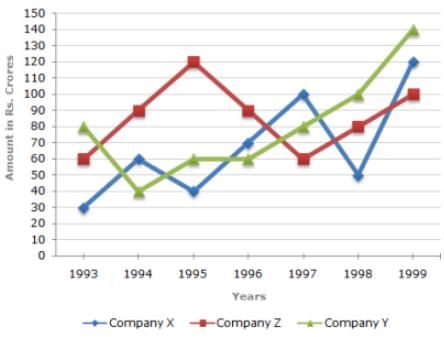
Q. Average annual exports during the given period for Company Y is approximately what percent of the average annual exports for Company Z?
The given Line graph Data Interpretation Chart shows the sales of shoes (in thousands) from six stores in six different cities Kolkata, Patna, Dhanbad, Ranchi, Asansol, and Gaya during three consecutive years 2014, 2015 and 2016.

Q. Total number of Campus shoes sales on Gaya store and Patna store together for three years is what percent of the total sales of Dhanbad store and Ranchi store together for three years?
Direction: Study the graph and answer the following questions :

The production of raw wool in 2014-15 was _______ of the production in 2019-20.
How many five digit numbers contain exactly one 3?
An alloy contains Brass, Iron and Zinc in the ratio 2:3:1 and another contains Iron, zinc and lead in the ratio 5:4:3.If equal weights of both alloys are melted together to form a third alloy, then what will be the weight of lead per kg in new alloy?
From a pack of 52 cards, two are drawn at random. Find the chance that one is a knave and the other a queen.
Even if / the teacher has completed the / course the students cannot pass / unless they study themself.
Either Nemmu or Mennu / are in the wrong; / both can / certainly never be.
Directions: Identify the words that are similar in meaning to the phrase in underline. If none of option conveys the correct meaning, mark (E) as your answer. The options do not necessarily need to be grammatically correct.
“I expect you to do the job well but don’t try to boil the ocean!”
Nazis did not exterminate the Jews in order to take their_________as most Jews were _________, and those who owned anything probably would have given it up gladly in order to save themselves.
Directions: Five statements are given below. Among these, four statements are in logical order and form a coherent paragraph/passage. From the given options, choose the option that does not fit into the theme of the passage.
His appearance is unsmiling but _______________.






